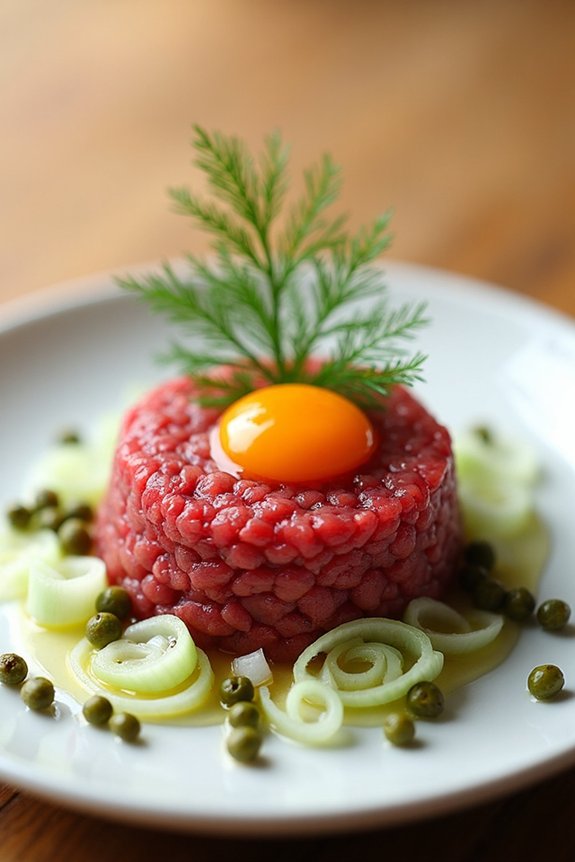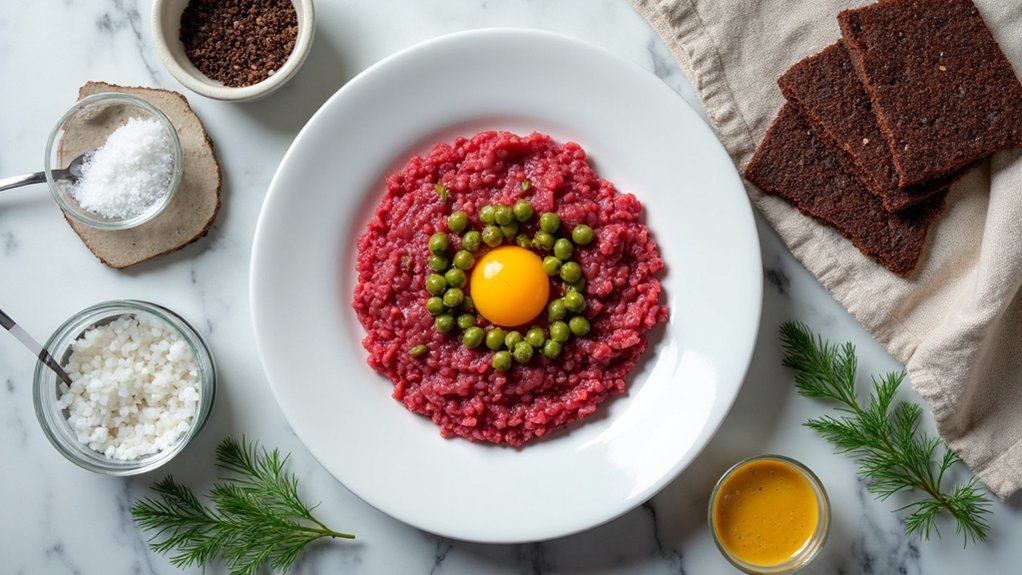I’ll be honest with you—when I first mention steak tartare to people, half of them light up with excitement while the other half look like I’ve suggested eating playground sand. But here’s the thing about Swedish steak tartare: it’s not just raw beef on a plate, it’s an art form that transforms quality ingredients into something surprisingly elegant. The Swedish approach takes this classic dish and makes it approachable, even for those who think they’d never touch raw meat.
Why you’ll love this dish
While most people think of steak tartare as intimidatingly fancy French fare, Swedish rabiff takes this raw beef classic and makes it wonderfully approachable.
I love how it strips away pretense, focusing on pure, clean flavors that let the beef shine. The presentation’s gorgeous too – imagine those golden egg yolks crowning perfectly shaped patties, surrounded by colorful garnishes arranged like compass points.
It’s restaurant-elegant but surprisingly simple to make at home. Plus, there’s something deeply satisfying about serving raw beef with confidence, watching guests’ faces light up when they taste that silky, rich texture.
Ingredients
The beauty of Swedish steak tartare lies in its simplicity – you need just a handful of quality ingredients to create something truly spectacular.
Unlike its French cousin that sometimes gets buried under fancy additions, rabiff keeps things clean and focused, letting each component play its part in ideal harmony.
- 1 1/2 pounds filet of beef, trimmed and very finely ground
- 1 onion, very finely chopped
- 3 tablespoons capers
- 3 tablespoons pickled beets, finely chopped
- 3 tablespoons grated horseradish
- 4 fresh eggs
- Salt (for serving)
- Black pepper (for serving)
- Dijon mustard (for serving)
Here’s where things get interesting – the quality of your beef will make or break this dish, so don’t even think about grabbing whatever’s on sale.
You want the absolute best filet you can afford, and honestly, building a relationship with a good butcher is worth its weight in gold here.
They can grind it fresh for you, which saves time and guarantees the perfect texture.
Those egg yolks need to be pristine too, bright orange and intact, since they’re basically the crown jewels of your presentation.
And while you might be tempted to prep everything hours ahead, resist that urge – this dish demands to be assembled and served immediately for food safety and ideal flavor.
Directions

The actual preparation is surprisingly straightforward, though you’ll want to work quickly since raw meat and room temperature aren’t exactly best friends. Start by shaping your 1 1/2 pounds of finely ground filet into four neat patties – think hamburger-shaped, but way more elegant.
Don’t season the meat at all, which might feel wrong if you’re used to cooking everything else, but trust the process here. The beauty happens when you arrange each patty on individual plates and create a little cross pattern around it using your accompaniments: place the finely chopped onion at twelve o’clock, 3 tablespoons of capers at three, the 3 tablespoons of pickled beets at six, and 3 tablespoons of grated horseradish at nine.
It’s like making edible art, and honestly, the visual impact alone will have people taking photos before they even think about eating.
Now comes the moment that separates the pros from the amateurs – cracking those 4 eggs and keeping the yolks intact. You want to separate them carefully, saving just the yolks for the final presentation.
Here’s where things get fancy: if you can serve the yolks in their actual shells, do it, because that’s the traditional way and looks absolutely stunning. Just crack each egg about a third of the way down, pour out the white, and nestle that shell with the perfect yolk right on top of each meat patty like a golden crown.
Set out small bowls of salt, black pepper, and Dijon mustard on the side, because part of the rabiff experience is letting everyone season their own portion exactly how they like it. The whole thing should be served immediately while everything is still ice-cold and fresh – no lingering allowed.
For the finest texture in your steak tartare, consider investing in a quality stainless steel meat grinder to achieve that perfect consistency that makes all the difference in this elegant dish.
Substitutions and Variations
Although traditional rabiff is pretty spectacular as-is, I get that not everyone can waltz into their local butcher shop and casually request premium filet of beef like they’re ordering a latte.
I’d swap filet for top sirloin or eye of round – just make sure it’s impeccably fresh.
Can’t find pickled beets? Roasted ones work fine, though you’ll miss that tangy punch.
No capers? Try finely chopped cornichons or even green olives.
For the horseradish-adverse, wasabi paste delivers similar heat.
Some folks mix everything together, but honestly, that’s missing the point of the elegant presentation.
Additional Things to Serve With This Dish
Since rabiff’s already doing most of the heavy lifting flavor-wise, you don’t need to overwhelm the plate with competing sides.
I keep things simple with crispy toast points or thin rye crackers—something sturdy enough to hold a generous bite. A small salad of peppery arugula dressed lightly in lemon vinaigrette cuts through the richness beautifully.
Some folks swear by boiled potatoes, but honestly, that feels heavy for such an elegant dish. Maybe add some cornichons or extra pickled vegetables if you’re feeling fancy.
The goal is supporting players, not scene-stealers.
Final Thought
Looking at this beautiful, raw masterpiece on your plate, I can’t help but think rabiff represents something pretty special in the cooking world—it’s one of those dishes that demands respect for both the ingredient and the technique.
There’s something almost meditative about the ritual of mixing each bite with your chosen accompaniments. The horseradish bite, the briny capers, that creamy yolk coating everything.
It’s not just dinner; it’s an experience that connects you to centuries of Swedish culinary tradition. Sometimes the simplest presentations create the most memorable meals.






